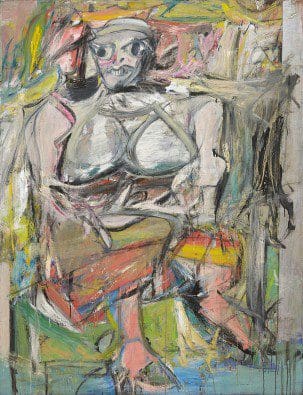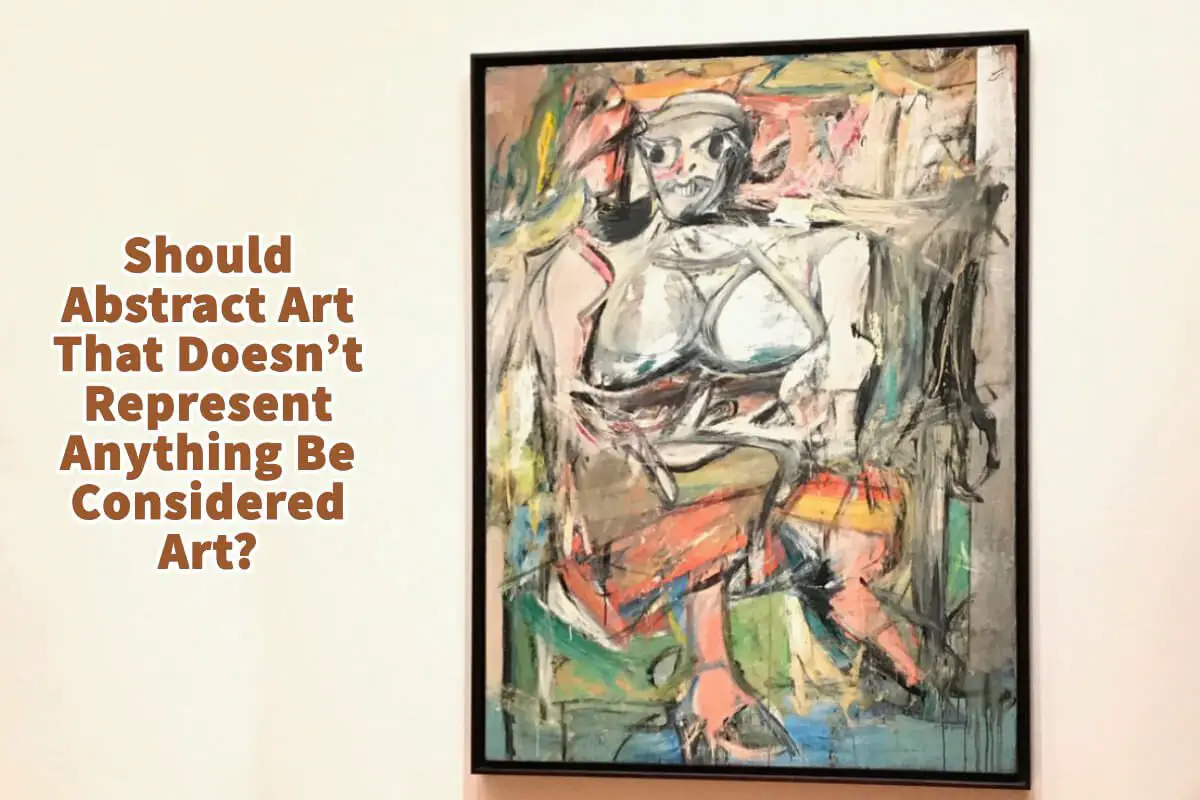Many want to understand if abstract art, particularly Abstract Expressionism, which does not seem to represent anything, is considered art.
It was a misconception in many fields that abstract art is not art. The truth is that abstract art is great because it is part of your experience with the art that makes Abstract art so unique. In this art, the artist takes something from the real world and puts their spin on what they view or how they view it.
Table of Contents
- The Misconception That Abstract Art Represents Nothing
- What Abstract Expressionism Art Does Represent
- Why Abstract Expressionism Is Great Art
- Frequently Asked Questions
- Related Questions
The Misconception That Abstract Art Represents Nothing
There is a misconception that many people feel that Abstract Expressionism or abstract art does not represent anything. Many think Abstract Art is just about the artist throwing or dripping paint onto the canvas, and it has no meaning.
Other times, people think that it is lazy art. Or it is an art that took little effort for the artist to make. Some people go as far as to say, “Well, my five-year-old could have easily painted that.”
Other people are amazed that something they consider such an ugly work of art could even make it into museums worldwide. And they are even more shocked when that same work of art or similar piece by the same artist may sell for millions of dollars at an art auction.
The difference between abstract art and many other art forms is that many of the meanings behind the art are hidden within the art itself.
If an artist paints a flower that we all understand, it represents a flower. But if an artist throws paint onto a canvas or paints a block with one single color, it may be harder for us to derive the meaning of that painting.
This is where the misconception comes in that many people feel that abstract art represents nothing when abstract art is art with some profound meaning that is meant to take you to another realm through art.
The artist wants you to view the art and to experience what you feel and how you feel about the art. The artist is not telling you how you should feel or react to the art; instead, they allow you to experience the art in terms of your own experience.
What Abstract Expressionism Art Does Represent
To understand what abstract art represents, we first need to understand what the meaning of abstract art is. The word abstract is used quite a bit in the art world.
The Tate Gallery in London defines abstract art as:
“Abstract art is art that does not attempt to represent an accurate depiction of a visual reality but instead use shapes, colours, forms and gestural marks to achieve its effect.”
Tate
So abstract art is not pretending to be anything that it is not. It is not trying to paint a building and tell us it is a flower when it does not t look like a flower. Abstract art is, as it says, about shapes, colors, forms, and gestural marks to achieve its effect.
Abstract Art Is About the Interpretation
Many people feel abstract art is tough to understand as abstract art is about interpretation. The artist may take a reference from the real world and then put their view or spin on it.
An artist who did this was the Abstract Expressionism artist Willem de Kooning. He has a series of Women’s paintings. The paintings show some general references to women, but it does not look like a woman.
Example of Abstract Art – Willem de Kooning Woman 1 – MOMA

When we look at the famous Willem de Kooning Painting Woman 1 at the Museum of Modern Art (MOMA) in New York City, there are several interesting parts to the painting. Here are some features that make this such a great abstract painting.
- Woman’s Eye – The eyes of his figure are oversized, and the woman looks a bit aggressive. But William de Kooning said he wanted it to look fun and for the woman not to look sad or downtrodden, so he made them satirical eyes or with humor.
- Mouth – Even the mouth is hard to find, and there is no proportion between the head, eyes, and mouth, but he did it that way—a way for us to think about the painting and what it means to us.
- Reworked Painting Many Times – It is challenging but extremely difficult to paint a great abstract painting. In this painting, Woman 1, Willem de Kooning was known to paint and repaint many parts repeatedly. So, on this painting is layer upon layer of paint where he worked and reworked the painting to get it exactly the way he wanted it to be. It took him at least two years to paint this painting.
In this painting, some may see a woman with angry and bulging eyes; others see a woman with big eyes and a sweet face. Willem de Kooning did not tell us how we should look at this; he left it up to us to experience the painting ourselves.
You can learn more about Willem de Kooning by reading Why Is Willem De Kooning’s “Interchange” The Most Expensive Painting? by clicking here.
Why Abstract Expressionism Is Great Art
Abstract art is great because it is an art we can experience on our terms. It is an art where two people may look at the same artwork but come up with two different meanings or feelings when they are looking at that painting.
Abstract art is great because it is about the viewer’s experience with the painting. We, as the viewer, can also participate in the process as we put our feelings and thoughts into the painting as we view it.
Anita Louise Art is dedicated to art education, great artists, and inspiring others to find and create their art. We love art that uplifts and inspires. #ArtToMakeYouSmile! #ArtToMakeYouHappy!
If you want to see any of my art, you can find out more by clicking here. If you are interested in what inspires me and my paintings, you can discover more by clicking here.
We have a free newsletter and would love you to be part of our community; you can subscribe to the newsletter by clicking here. I would be happy to talk to you if you have any questions. You can reach me, Anita, by clicking here.
Subscribe to our Anita Louise Art YouTube Channel with great videos and information by clicking here.
Join us for our podcast “5 Minutes With Art.” Spend just 5 minutes a week with us to discover and learn about great art and artists. You can find out more about our podcast by clicking here.
Frequently Asked Questions
What is abstract art, and how does it differ from representational art?
Abstract art is a style that does not attempt to depict an accurate representation of visual reality. Unlike representational art, which aims to portray recognizable objects or scenes, abstract art focuses on shapes, colors, and forms divorced from specific references.
Does abstract art have any inherent meaning, or is it open to interpretation?
Abstract art often lacks a direct representation of identifiable objects. Instead, it relies on the viewer’s interpretation, emotions, and personal experiences to derive meaning from the artwork.
Is Abstract Expressionism a form of abstract art that doesn’t represent anything?
Yes, Abstract Expressionism is a prominent style within abstract art. It emphasizes the artist’s spontaneous, emotional expression rather than attempting to depict recognizable subjects.
Why should abstract art that doesn’t represent anything be considered art?
Abstract art is a unique form of expression where artists take elements from the real world and present them in a subjective, innovative manner. The value lies in the viewer’s engagement and the artist’s creative interpretation.
Can abstract art evoke emotions and connections without a clear representation of objects?
Absolutely. Abstract art has the power to evoke emotions, trigger memories, and create a connection with viewers through the use of color, composition, and form, even in the absence of recognizable subject matter.
How does the artist’s perspective contribute to the significance of abstract art?
Abstract artists bring their unique perspectives and interpretations to the forefront, allowing viewers to experience the world through their eyes. The artist’s individuality adds depth and meaning to abstract artworks.
Is there a historical context that supports the recognition of abstract art as a legitimate form of artistic expression?
Yes, abstract art has a rich history dating back to the early 20th century, with movements like Cubism and Abstract Expressionism challenging traditional representational norms. Over time, the art world has widely accepted abstract forms as legitimate expressions of creativity.
Can anyone appreciate abstract art, or does it require a certain level of understanding?
Abstract art is accessible to everyone, regardless of artistic knowledge. The beauty of abstract art lies in its openness to interpretation, allowing each viewer to connect with it on a personal level.
Related Questions
What Is The Cultural Significance Of Abstract Expressionism Art?
The cultural significance of abstract expressionism art is it was a forerunner for the cultural changes that took place in the United States in the 1950s and 1960s. The Abstract Expressionism movement started after World War II in the 1940s and continued into the 1950s. The world saw great cultural shifts in the 1950s and the 1960s.
By clicking here, you can learn more by reading What Is The Cultural Significance Of Abstract Expressionism Art?.
What Does Conceptual Art Mean? The Conceptual Art Movement
Conceptual art uses whatever materials, techniques, or form that the artist feels is most appropriate for the artist to get their artistic ideas across. Conceptual art can be almost anything from a display of objects to photographs to a performance. Almost anything goes with the Conceptual Art Movement.
You can discover more by reading What Does Conceptual Art Mean? The Conceptual Art Movement by clicking here.
The Important Role Of Art Museums In The Art World
An art museum will help to collect and preserve works of art. They also interpret the art and help to educate us all about art. Many art museums will have programs that will allow you to even experiment with different types of art. The core role of an art museum is to inspire us about art.
You can learn more by reading The Important Role Of Art Museums In The Art World by clicking here.


